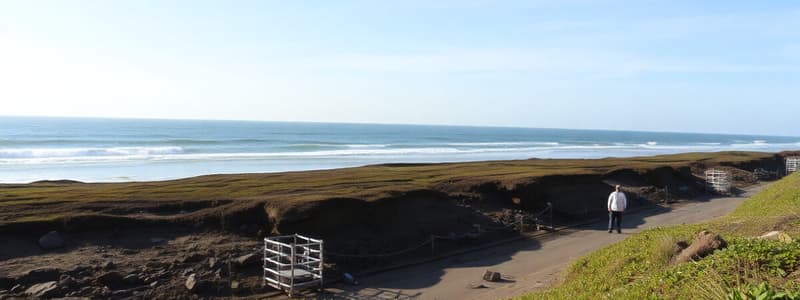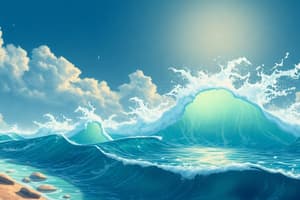Podcast
Questions and Answers
What are two natural causes of coastal flooding?
What are two natural causes of coastal flooding?
Storm surges and tsunamis.
How can forecasting help reduce the impact of coastal flooding?
How can forecasting help reduce the impact of coastal flooding?
Forecasting allows predictions of when floods might occur, helping people prepare and stay safe.
Describe one method of soft engineering used to protect coastlines.
Describe one method of soft engineering used to protect coastlines.
Beach replenishment involves adding more sand to beaches to combat erosion.
What is managed retreat in coastal management?
What is managed retreat in coastal management?
Name one type of hard engineering structure used to protect coastlines and its function.
Name one type of hard engineering structure used to protect coastlines and its function.
What natural processes contribute to the shaping of coasts?
What natural processes contribute to the shaping of coasts?
How do geological factors influence coastal environments?
How do geological factors influence coastal environments?
List two types of landforms created by natural coastal processes.
List two types of landforms created by natural coastal processes.
What are mangroves, and where are they typically found?
What are mangroves, and where are they typically found?
What human activities can damage coastal ecosystems?
What human activities can damage coastal ecosystems?
Why is it important to manage coasts effectively?
Why is it important to manage coasts effectively?
Describe a conflict that may arise over coastal management.
Describe a conflict that may arise over coastal management.
What are some examples of coastal ecosystems?
What are some examples of coastal ecosystems?
Flashcards
Coastal Erosion
Coastal Erosion
The wearing away of land by waves, currents, and other natural forces.
Coastal Deposition
Coastal Deposition
The process where sediments (sand, rocks) are dropped by waves and currents.
Headland and Bay
Headland and Bay
A headland is a part of the coast that sticks out into the sea, while a bay is a sheltered area of the coast.
Coastal Ecosystem
Coastal Ecosystem
Signup and view all the flashcards
Mangroves
Mangroves
Signup and view all the flashcards
Coastal Management
Coastal Management
Signup and view all the flashcards
Human Impact on Coasts
Human Impact on Coasts
Signup and view all the flashcards
Coastal Landforms
Coastal Landforms
Signup and view all the flashcards
Coastal Flooding Causes
Coastal Flooding Causes
Signup and view all the flashcards
Soft Engineering
Soft Engineering
Signup and view all the flashcards
Hard Engineering
Hard Engineering
Signup and view all the flashcards
Shoreline Management Plans
Shoreline Management Plans
Signup and view all the flashcards
Coastal Development vs Conservation
Coastal Development vs Conservation
Signup and view all the flashcards
Study Notes
Coastal Environments
- Coasts constantly change due to natural processes like waves, weathering, and mass movement.
- Coast shape depends on rock type, nearby plants/trees, and human activities.
- Natural processes like erosion/deposition create landforms: headlands, bays, cliffs, wave-cut platforms, caves, arches, stacks, beaches, spits, and bars.
- Coastal ecosystems include coral reefs, sand dunes, salt marshes, and mangroves.
- Features of coastal ecosystems: non-living things (sand, water) and living things (plants, animals).
- Human activities can damage coastal ecosystems (deforestation, building factories, tourism, farming practices).
- Conflicts arise over coastal use (conservation vs. development).
- Coastal flooding caused by storms, tsunamis, and climate change.
- People use methods like forecasting, designing flood-resistant buildings, and education to reduce the impact of floods.
- Soft engineering protects coasts by working with nature (beach replenishment, cliff regrading, ecosystem rehabilitation).
- Hard engineering involves building structures (groynes, revetments, seawalls, gabions, riprap) to protect shorelines.
- Shoreline management plans decide the best method to protect and manage specific coastlines.
Studying That Suits You
Use AI to generate personalized quizzes and flashcards to suit your learning preferences.




